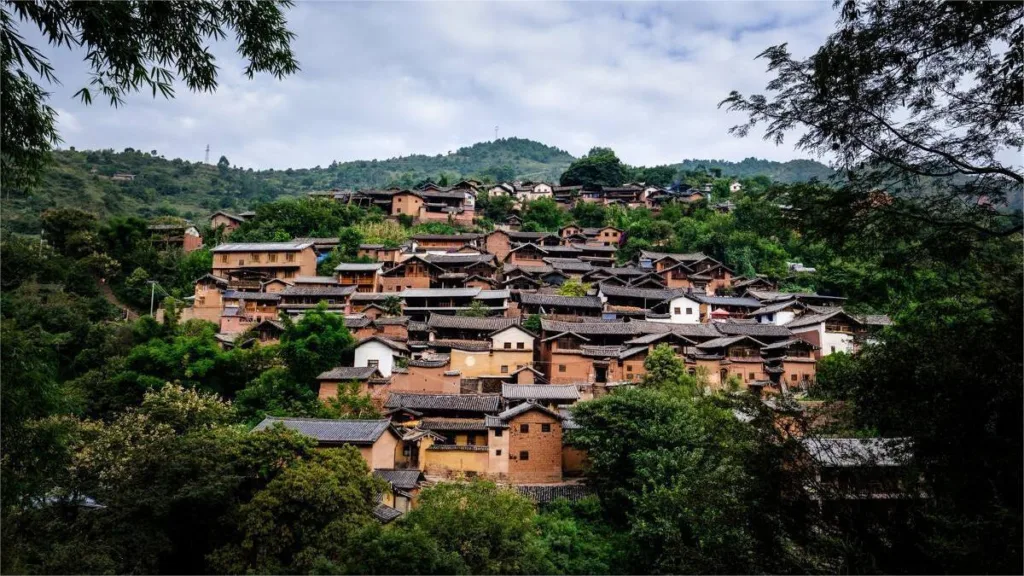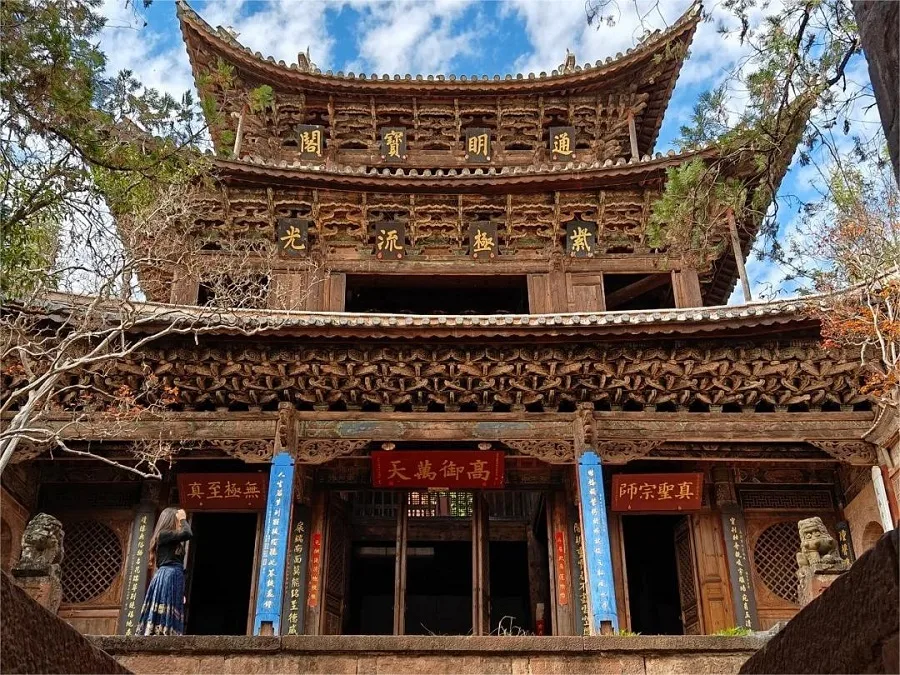Nuodeng Village, Yunnan - Kaartje, openingstijden, locatie en hoogtepunten


Nuodeng Village (诺邓村), situated in Yunlong County, Yunnan Province, is the earliest economic hub of the Bai ethnic group and one of the oldest villages in northwestern Yunnan. It is also one of the few villages whose original name remains unchanged since its mention in the earliest historical records like the “Man Shu,” making it a repository of Ming and Qing dynasty architecture and the renowned Jade Emperor Pavilion Taoist architectural complex.
The name “Nuodeng” translates to “hillside with tigers” in the Bai language. This village, documented in historical records and spanning 1138 years from the Tang to the Qing Dynasty, was once a significant location in ancient times. Dating back to at least the Tang Dynasty, Nuodeng was involved in salt production, relying on salt wells for its livelihood. The quality of Nuodeng salt was exceptional, and regions like Baoshan and Tengchong have long favored “Nuodeng Salt” for consumption. The ancient Tea Horse Road of Nuodeng extended east to Dali and Kunming, south to Baoshan and Tengchong, west to Liuku, and north to Lanping and Lijiang, attracting merchants from all directions and flourishing with various industries. At one point in history, Nuodeng Village emerged as a commercial center in western Yunnan.
Inhoudsopgave
Basisinformatie
| Geschatte lengte van de tour | 1 dag |
| Ticket Prijs | Gratis |
| Openingstijden | 24 uur per dag, het hele jaar door |
Locatie en vervoer
Nuodeng Village is located in Yunlong County, Dali Bai Autonomous Prefecture, Yunnan Province, approximately 165 kilometers from the prefectural capital of Dali. Here are three ways to reach Nuodeng:
- Renting a Car: Upon arriving at Dali High-speed Railway Station, you can find car rental services nearby. From there, you can drive directly to Nuodeng, which takes about two hours.
- Coach: There are buses available at Dali High-speed Railway Station that travel to the parking lot near the village.
- Public Transport: From Dali Bus Passenger Transport Station, you can take a shuttle bus to Yunlong County, which takes about three hours. Upon reaching Yunlong County, you can then take a passenger vehicle for approximately 10 minutes to Nuodeng Village.
Highlights of Nuodeng Village

Ancient Salt Wells
Dating back over two millennia to the Han Dynasty, Nuodeng’s salt wells stand as a testament to its ancient salt production industry. The wells, notably a 21-meter deep vertical well, were used to extract brine, which was then distributed to households for salt production through traditional methods.
Ancient Residences
The traditional residences in Nuodeng, nestled against the northern mountains, are characterized by their layered construction, courtyards, and unique architectural styles. The homes, often interconnected, form a complex network of alleys and streets, showcasing the village’s distinctive architectural heritage.
Salt Trade and Salt Bureau
Nuodeng’s history as a salt-producing center is evident in its Salt Street and the remnants of the Salt Bureau. In ancient times, salt produced by households was collected and distributed by the Salt Bureau for trade. Nuodeng played a crucial role in the salt trade along the ancient Tea Horse Road, with caravans departing for destinations like Dali, Baoshan, Tengchong, Myanmar, Lijiang, and Tibet. During the Ming Dynasty, the annual salt tax revenue sent to the central government from Nuodeng amounted to 38,000 taels of silver.

Wanshou Palace
The Wanshou Palace ruins stand as one of the oldest structures in the village. Originally a Jiangxi Guild Hall during the Yuan Dynasty, it was converted into a temple known as the “Zhushou Temple” in the early Ming Dynasty. Later, it was rebuilt and renamed “Wanshou Palace” during the Jiajing reign. The stone stele inscribed with poetry by Li Qiong, who oversaw the reconstruction, still remains today, adding to the historical significance of the site.
Salt Tax Office
In 1383, during the Ming Dynasty, the government established seven “Salt Tax Offices” across the country, with Yunnan being home to four. Nuodeng housed one of these offices, known as the “Wu Jing Salt Tax Office.” Although the office was later relocated, its original site evolved into the private residence of the Huang family. The family transformed the former gate of the Salt Tax Office into a “Name Inscription Archway,” commemorating the family members who achieved success in the imperial examinations. During the Qing Dynasty, the Huang family produced two Jinshi scholars, five Juren scholars, and over a hundred scholars, with Huang Gui gaining fame as a renowned scholar during the Kangxi and Qianlong reigns.

Taoist Altar
Since the Ming and Qing Dynasties, Taoism has exerted significant influence in the Nuodeng area. The village is home to the former residence of a prominent Taoist master from the late Qing Dynasty to the early Republic of China period. One distinctive feature of the residence is the front courtyard altar, where rituals and performances of Taoist scriptures were conducted.
Terrace Market
In ancient times, Nuodeng hosted four market days each month. Due to spatial constraints, the markets were held in the western part of the village, near the village’s tail end. The marketplace featured a long stone staircase, with butcher shops lining its sides. Legend has it that leopards would occasionally fall to their demise from the steep stairs while attempting to steal meat, highlighting the staircase’s steep incline.

Salt Horse Ancient Road
To the north of the village, remnants of the ancient stone-paved roads of the “Salt (Tea) Horse Ancient Roads” can be found. These roads connected Nuodeng to destinations such as Dali to the east, Baoshan to the south, Tengchong and Myanmar to the west, and Lijiang and Tibet to the north. These roads served as vital trade routes, traversing mountains and valleys and converging at Nuodeng. Along the mountain paths, remnants of ancient virtue archways can still be seen, serving as a testament to the historical importance of these trade routes.
Confucian Temple
Despite not being a county seat, Nuodeng boasts a Confucian Temple, a rarity in ancient ceremonial customs. The Nuodeng Confucian Temple exudes elegance and simplicity in its architecture, featuring the “Zhi Sheng Palace,” where a statue of Confucius in humble attire, rather than imperial robes, is enshrined. This depiction contrasts with statues found in other temples, symbolizing Confucius’s role as a teacher and exemplar of virtue. Adjacent to the Confucian Temple dedicated to the “Sage of Literature” is a temple honoring the “Martial Sage” Guan Gong.

Lingxing Archway
Fronting the Nuodeng Confucian Temple is the “Lingxing Archway,” the largest and oldest surviving wooden archway in the western Yunnan region. Constructed in the early Qing Dynasty, this archway, also known as the “Soaring Dragon, Rising Phoenix” Archway, features four pillars, three beams, and intricate flying eaves adorned with carved brackets.
Jade Emperor Pavilion Star Map
The Jade Emperor Pavilion is a rare three-story pavilion-style ancient building in western Yunnan. Dating back to the Ming Dynasty, it served as a renowned Taoist temple in ancient times. Within the courtyard, ancient trees such as plum, cypress, wisteria, and cinnamon adorn the surroundings. The highlight of the pavilion is the surviving celestial ceiling painting depicting the “Twenty-Eight Constellations,” which is considered a masterpiece of Nuodeng. This artwork holds significant value in the study of ancient Chinese cosmology, astronomy, art, and architecture.
Dali bezienswaardigheden, Historische plaatsen in Yunnan